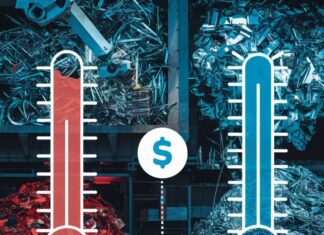Nowadays, businesses decide to cooperate with external developers instead of launching in-house IT departments. Outsourcing isn’t a new trend but it remains on high popularity level for several years in a row. Although the peak of the market size was in 2014 ($104.6 billion), the past year was positive, as well ($85.6 billion). Development teams can save resources, so let’s dive in the topic a bit deeper.

First and foremost, we should figure out who are outsourcing developers and how they work. There are two basic models of partnership which pros and cons we will review in the next section. Getting a dedicated team refers to the offshoring scheme based on a contract with exact specifications of work, rights and obligations, expenses, and timeframes. Here, a client controls everything while developers are responsible for the creation and support.
But what’s the best approach to apps’ deployment or maintenance of existing software? How can outsourcers help? Which pitfalls are important to know? Read on to find answers!
Hiring Outsourcers VS Building Own Team

The first model described above is clear, but there’s an alternative based on creating an inner team of IT professionals. In both cases, managers can find members with the most relevant skills, but some differences appear, too:
- Hiring. With an external team, you get a solid collaborated team at once. Instead, to build a new department, you have to engage experts one by one.
- Workflow. Outsourcers have stable working schemes and they quickly replace a sick or fired member. When you manage your own team, processes can slow down when a given professional decides to rest a bit.
- Control. Teamwork with external companies requires a lot of remote control with proper tasking and reporting while in-house members always work side by side.
- Costs. According to Saigon Technology, the TCO of the outsourced product consists of hourly rates or the final project price only. In-house staff requires regular salaries and extra operation spends.
Summarizing the pros and cons, we have the most valuable hint: choose the cooperation model considering your demands. Cases with great requirements to security can’t exist without trusted inner developers who dedicate all their time to the work. But most of all startups or established corporations can get benefits from an external partnership which cuts the TCO and releases you from HR headache.
If you want to learn about development teams, check more info here. Further in this article, we will focus on outsourcers, as well.
Cool Developers and Where to Find Them

The cooperation begins with an initial search. Generally, there are two approaches to finding external employees: Internet-based and personal.
Firstly, you can look for staff by simple browsing or targeted search in professional communities (Upwork) or networks (LinkedIn). Be sure to check reviews of the chosen company, explore its projects etc. The Internet-based way is convenient and versatile because of quick response and big arrays of data.
The second approach provides for in-person discussion on various conferences and meetings. Your PR team can attend industry-definitive events to find free developers or companies. Otherwise, it’s possible to contact professionals by recommendation from colleagues. Thus, you will be sure about their reliability.
The most elaborate approach to cooperation is based on MSPs or Managed Service Providers. These squads handle all possible developments, further upgrading, and lifelong support. Usually, MSPs tend to become tech partners instead of freelancers, so they guarantee top-notch quality and timeliness.
The Hiring Process

Once you’ve found the dream-team, another essential stage begins. Careful planning, checking contracts, and approving all possible and impossible conditions are key steps to successful cooperation. Hence, we prepared the ultimate checklist for brands which are going to begin working with outsourcers:
- Contact people. The first thing to do is to talk with developers. We suggest meeting in real life or, at least, talking via Skype or Hangouts.
- Sign PRD. This basic paper concludes the functions, work scope, time, and costs. Put simply, it’s a list of your requirements which shouldn’t be changed.
- Sign FCD. This document is a more detailed version of PRD focused on the product’s features. It may list tasks, technologies, and conditions.
- Approve start. After all terms are concluded, tech partners can begin working by creating MVP, deploying it, and showing core functions to your employees.
- Control iterations. If you have hired Agile developers, they will show multiple variations of the product with the required updates.
- Wait for tests. Before the start, be sure to get test results from the QA team. It’s vital for every project to be released without bugs.
- Deploy the product. Once the business is happy with the project, it’s time to launch it, train in-house staff, and enjoy.
- Evaluate performance. Finally, remember about reviews. If the software doesn’t bring expected results, contact developers and ask them about issues.
- Work on. However, if everything’s good, consider working with the team. MSPs can provide more updates, customer and tech support.
Skilled outsourcers can help with each step, not with the product’s creation only. For example, if you don’t clearly realize which features software must contain, just consult with partners. Hence, they will be able to analyze the business and turn your idea into the real-world product with top features.
Pro Tips on Hiring Developers

At last, we have prepared some hints from both businessmen and outsourcers who have solid experience in working together. Explore the list to know how to avoid unnecessary miscommunications and issues:
Don’t ignore geography. According to Elinext, Asia features the smallest hourly rates (from $15 for Junior QA), the US has the highest level (at least $77) while Eastern Europe has the best balance between prices and quality (from $25).
- Remember about tech. If you have enough knowledge of programming languages and frameworks, be sure to mention desired ones in PRD. Or consult with coders to understand the pros and cons of each approach.
- Ask for MVP. It’s always better to get a test sample before ordering the entire work. Qualified developers offer the software with basic functions aka Minimum Viable Product which is wonderful to check how apps work.
- Consult with side experts. Sometimes, neither you nor workers can analyze the outsourcers’ performance properly. In this case, it will be better to hire a third-party professional that knows everything about the industry.
- Listen to your heart. Partnership with external teams requires tons of your time and resources, both financial and personal. It’s much more difficult to develop long-lasting relations with people you don’t like.
Surely, research is the king of any partnership, so we recommend conducting a proper market study before choosing the exact developer. Just believe that money spent on exploration can save way higher costs of incompetent teams’ errors. Good luck!









